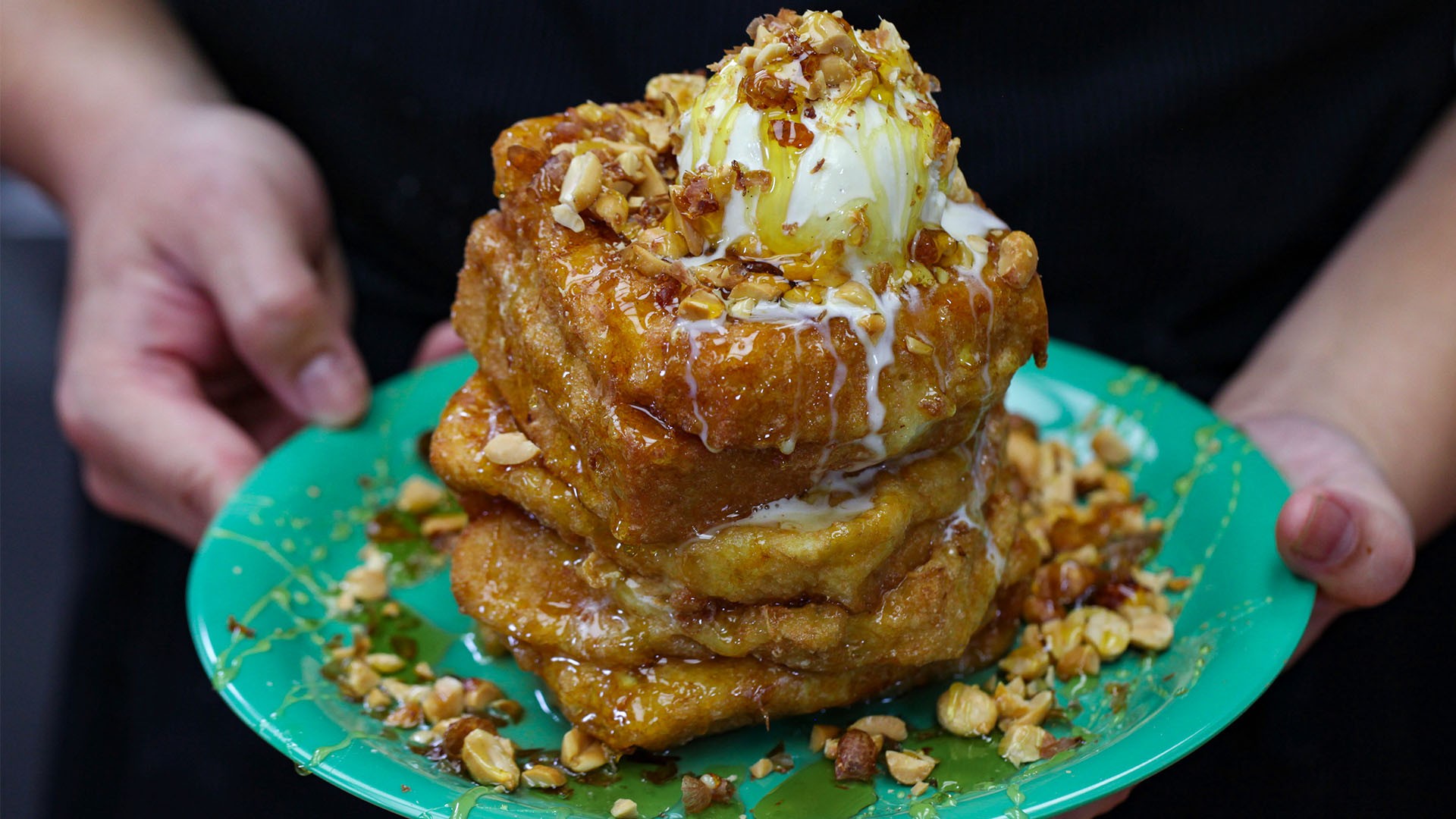When we can't dine together as we did before the pandemic, what does it look like to find community through food?
Advertisement
Since 2015, Junzi Kitchen has brought fast casual, seasonally focused Chinese food to its four locations in New York City and New Haven. Chef Lucas Sin, a young entrepreneur who once ran a pop-up out of his dorm room at Yale, steers Junzi's culinary focus. On March 16, New York governor Andrew Cuomo shut down the city's restaurants, and just two weeks later, Sin announced Junzi's Distance Dining series, a weekly, delivery-only, themed dinner with a component on Instagram Live that ran for 13 weeks. On September 30, New York City will resume indoor dining at 25 percent capacity.Sin told VICE about how the pandemic has shaped his approach to collaboration, and how virtual dinners might feature in Junzi's approach moving forward.
“We are a fast casual restaurant, so most of the business [before COVID-19] was takeout and delivery; we never stopped doing that throughout the pandemic. Before Distance Dining, before COVID, I had run this series—since we opened in New Haven about four years ago—called Chef's Study. These menus were always structured like "Chinese x ____," and the idea was to look at some niche aspect of Chinese food.I wanted to continue that energy of investigation via tasting menus. We started doing this three-course tasting menu that we deliver to people's doors, every Friday. We want it to be collaborative in nature, so oftentimes, we cook with other chefs. Every time, the menu is different and the theme is different, but it always revolves around the relationship between Chinese cooking and that cuisine. We're looking at borders, immigration, foodways, politics, and that sort of thing. The hope is to start a conversation.
“We are a fast casual restaurant, so most of the business [before COVID-19] was takeout and delivery; we never stopped doing that throughout the pandemic. Before Distance Dining, before COVID, I had run this series—since we opened in New Haven about four years ago—called Chef's Study. These menus were always structured like "Chinese x ____," and the idea was to look at some niche aspect of Chinese food.I wanted to continue that energy of investigation via tasting menus. We started doing this three-course tasting menu that we deliver to people's doors, every Friday. We want it to be collaborative in nature, so oftentimes, we cook with other chefs. Every time, the menu is different and the theme is different, but it always revolves around the relationship between Chinese cooking and that cuisine. We're looking at borders, immigration, foodways, politics, and that sort of thing. The hope is to start a conversation.
Advertisement
In a fast casual restaurant, you only have so many minutes to spend with somebody. In the Distance Dining packet, we give them a menu that has a letter, and it also has detailed stories behind each course. Those little pockets of history are things that you can spend time with. Distance Dining, I think, certainly is more engaging than fast casual, but I also like to think that it complements it: You can't have a history lesson every single time you eat, but you also can't be totally thoughtless every time you eat, too.
I've really found the tasting menu series to be an incredible way for me to learn more about Chinese cuisine—which I'm eternally a student of—but also other cuisines and cultures. With the West African dinner we did with Pierre Thiam and Teranga, there isn't a lot of West African-Chinese connection, because there aren't a tremendous amount of Chinese people in West Africa, so we had to look at the culinary foundations of the cuisine.We found a couple of things, like ancient grains and fermentation, were really essential, and we asked ourselves: What is the role of these ancient grains in China versus West Africa? What connection can we draw between fermented locust bean, which is dawadawa, and fermented fava beans, like doubanjiang? How are they used culinarily, what is the similarity, what is the difference? Because we don't know what's around the corner tomorrow, the form of it may change, but I want the spirit of collaboration and global culinary connection to keep going.I want the spirit of collaboration and global culinary connection to keep going.
Advertisement
Collaboration in real life is difficult as-is, without the pandemic. With Kia Damon, who was a chef at Lalito and then Cherry Bombe, we were always within each other's spheres, but we'd never met. [But there] was a connection between Louisiana and Sichuan that we found and wanted to emphasize, and that was really a product of [our] conversation. It genuinely is a conversation between two chefs with the express goal of writing a menu together, even if you don't know each other that well. It would be erroneous to [try] to write a culturally collaborative menu with an agenda. If you already know what you're going to make walking into a collaboration, then it's not collaboration. You want to learn each other's cuisine, and something magical always ends up happening.
With the George Floyd protests, we did take a pause with Distance Dining, because I, myself, and my team needed the time and space to reflect. We decided to restart Distance Dining with the expressed purpose and focus of engaging more Black chefs and to amplify Black voices. We hadn't worked with any Black chefs before, but also, when most people think about collaborative Chinese cooking, they don't often turn to African American cooking or African cooking or Caribbean cooking, for example. It's a difficult conversation that encompasses the complicated politics of cuisine, [as well as the] Asian American, African American, and Black American communities.I've always loved cooking in New York because of the sense of camaraderie and community.
Advertisement
The Instagram Live component is important because the two chefs talk about the inspiration behind the dish, but we also show you how to reheat the dishes and to plate the visuals to make it look a little prettier than your regular takeout. We don't know what Distance Dining is going to look like in the future, but plating food together virtually, with other people, is also something that I hope we can find a way to continue.In the beginning of COVID, we relied very much on WhatsApp groups and WeChat groups, some that had been formed in response to the pandemic. We all wanted to talk and share information. That was pretty helpful as a way to understand what the rest of the industry was going through—as a benchmark, but also as a resource. Perhaps more importantly, I think I turned to my community immediately for inspiration for what to do. A huge part of Junzi's COVID response was supporting our frontline workers and sending meals through a program that we set up called Share a Meal. That was in no small part inspired by programs like Heart of Dinner or Bento Essentials by our friends over at Kopitiam, 886, and Raku. It just so happens that these people are also our friends, but watching them pivot so quickly was really inspiring for me and my team.I've always loved cooking in New York because of the sense of camaraderie and community. I wouldn't want to diminish the fact that before COVID, at least in the circle I was in, I've always felt very supported by the industry and community. It is on another level now—people seem to be more happy to reach out and ask for help, and more willing to help each other out. There are 40,000 Chinese restaurants all over the United States, but the fact that they formed without a headquarters, without a single brand uniting them so to speak, speaks to the massive competition.One of our focuses—or one of my interests, right now—is to figure out how we can use the new support groups to foster a sense of solidarity, especially in light of Black Lives Matter. We can start conversations that didn't exist because those spaces didn't really exist before this. That, I think, is a very powerful thing and certainly will continue after COVID.”This interview has been edited and condensed for length and clarity.

